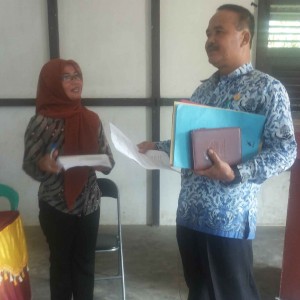Yeni Januarti is a 40-year-old mother of four, housewife and activist in her community. She’s also on the leading edge of Indonesia’s battle against stunting.
Stunting is one of the most visible effects of malnutrition. Even though Indonesia is one of Asia’s largest economies, it maintains one of the world’s highest malnutrition rates.
“Most people are not aware that stunting is a huge issue in Indonesia,” IMA project lead Iwan Hasan says. “More than one-third of Indonesians under 5 years are stunted and that is a big problem. A child’s future is significantly affected by nutrition in their first 1,000 days from conception to 2 years so educating parents about the importance of this issue can have a big impact on their children’s lives.”
The National Nutrition Communications Campaign project is a three-year $4.1 million effort implemented by IMA World Health. It is part of the larger Community-Based Health and Nutrition to Reduce Stunting Project, funded by the Millennium Challenge Account in Indonesia and working with the country’s government.
Overall, the effort aims to reduce Indonesia’s stunting through a comprehensive effort.
On the back of a motorcycle, Januarti travels four hours to reach Landak, a rural district in the Kalimantan Regency. The district has one of the highest stunting rates in Indonesia, at 32 percent. The Government of Indonesia designated Landak as one of the focus regions for NNCC.
AT-A-GLANCE
Timeframe: 2014-2017
Funding level: $4.1 million (US)
Donor: Millennium Challenge Corporation, Indonesia
IMA’s Role: Lead Agency
Landak District has one of the highest stunting rates in Indonesia with 32 percent.
“In Indonesia, for a campaign to be successful, it’s imperative that our project coordinates closely and develops strong working relationships with all stakeholders, including government counterparts, community leaders, religious leaders and NGOs,” IMA Senior Program Officer Scott Torres says. “We could not be successful in our work if people like Ibu Yeni and so many of our other dedicated partners were not on the ground working to advocate for stunting in Indonesia.”

Januarti meeting with different leaders in the community as part of her advocacy work to reduce stunting
As a program manager Januarti is the local face of the effort to reduce stunting in Landak. She meets with members of the government, religious leaders, community leaders and even the Head of Landak District to talk about these important issues.
Advocacy in Indonesia, especially on issues like stunting, follows a specific and important approach that requires buy-in at all levels. Policy reform, starts with Januarti approaching decision makers in the government sector of Landak District, such as the Bappeda (District Planning Bureau), District Health Office, Ministry of Religious Affairs and Puskesmas (Community Health Center). Government is decentralized and policy reform, while influenced at the national level, is made at the district level.
Religious and faith leaders also have a powerful role in the community, and Januarti spends time with Catholic, Christian, Confucius, Islam and Hindu leaders talking to them about stunting. Trusted and influential leaders play a key role in raising awareness and creating behavior change in the community.
Officials in Landak District appointed Januarti as a facility and resource person. Working as a bridge between government offices, she is able to portray the importance of conducting coordinated activities in order to effectively reduce the stunting rate. Januarti was able to convince stakeholders at the sub-district level to include stunting reduction in the annual development budget for two sub-districts.
The involvement of the health district leader, or Bupati, is crucial for securing funding and prioritization. As head of the health district, Dr. Andreanus Asia Sidat, convened a team to address stunting that includes the Ministry of Public Works, the District Agriculture Office, and the Ministry of Religious Affairs and the District Education Office. The responsibility of this team will be to improve nutrition for children under 5 years, especially in the first 1,000 days of life in Landak also known as 1,000 HPK.
IMA’s NNCC project not only raises awareness about the issue but it also educates mothers and communities about the long-term effects of stunting, and how to reduce it. This is the start of a long and challenging process but with the support of the local government and people like Januarti who play a pivotal role in taking this project forward, ending childhood stunting in Landak District is possible.


